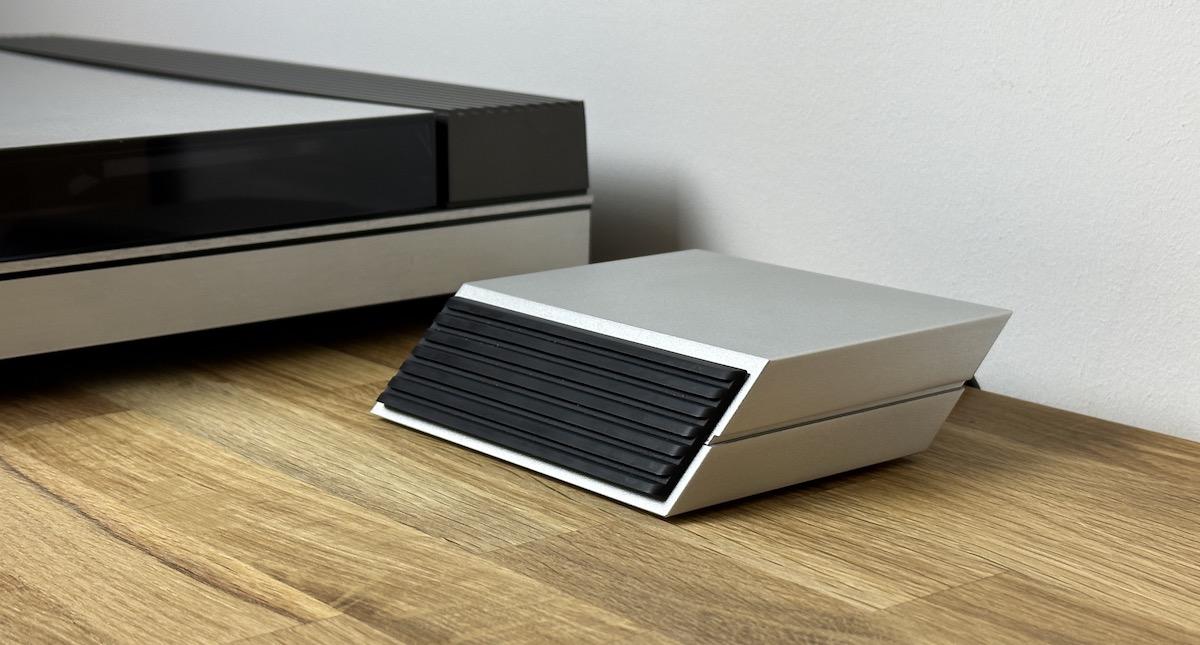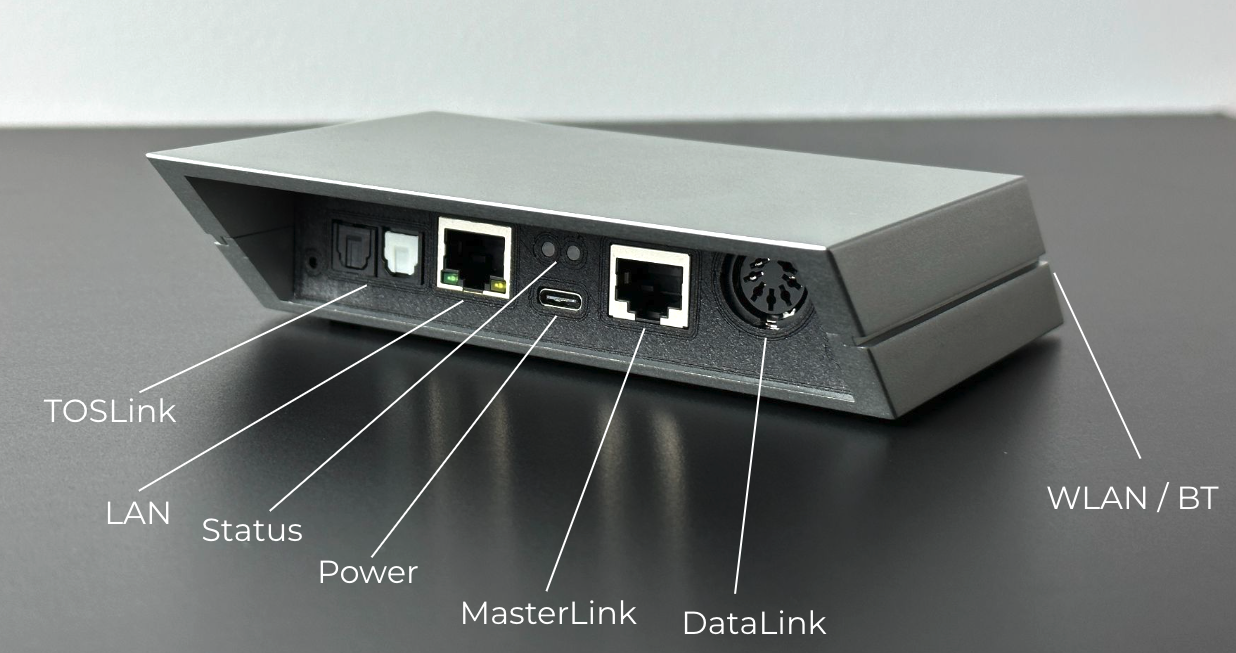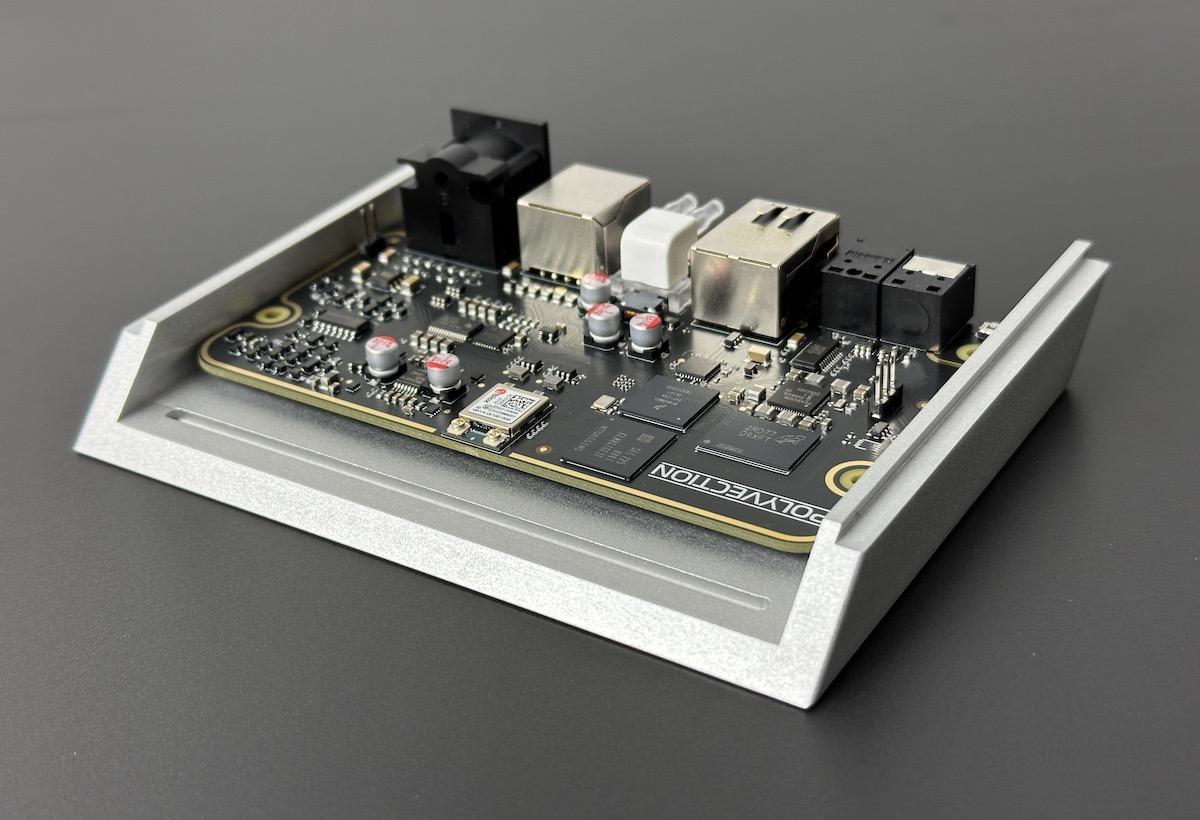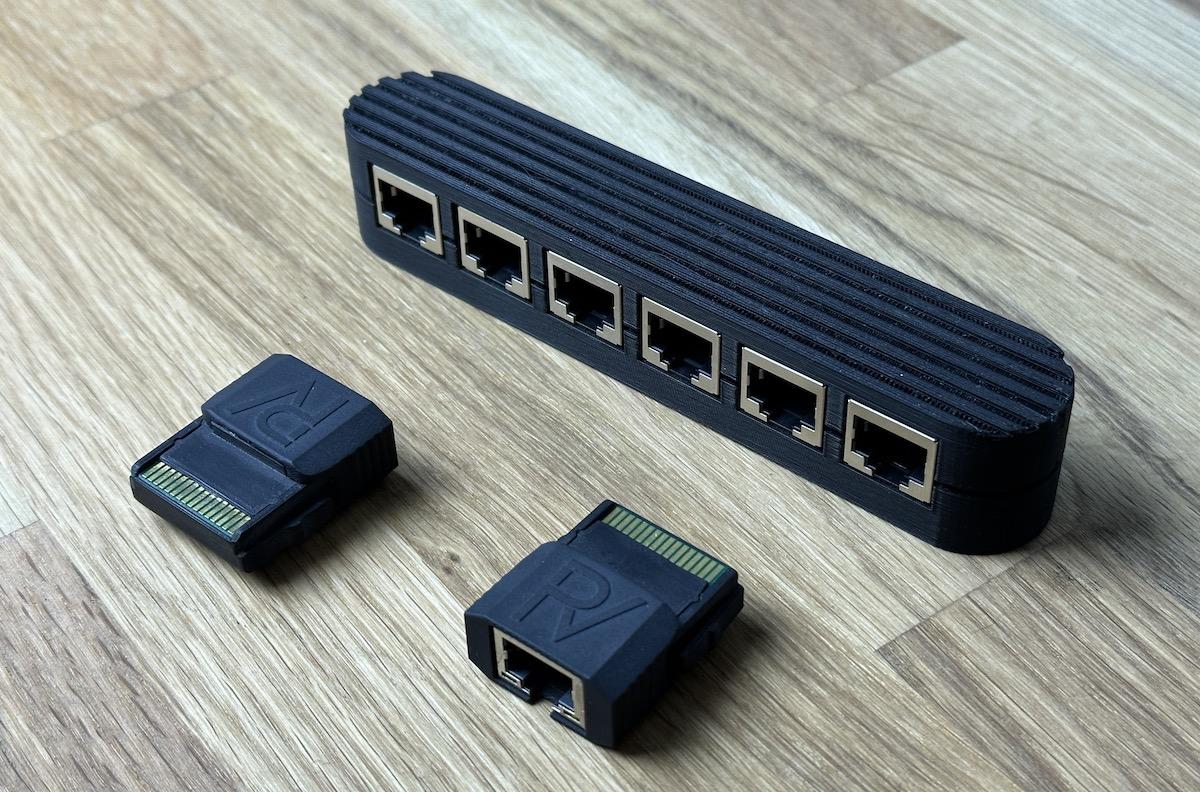Universal Link Adapter
- This topic has 68 replies, 16 voices, and was last updated 1 year, 1 month ago by
B3OHACK3R.
- AuthorPosts
- October 11, 2023 at 10:14 pm #24801
Dear Beoworld
This one has been in my head for a couple of years now but I never really had the time taking care of it. Well, I finally pulled the trigger. So let me introduce the Universal (Beo)Link Adapter.
A device completely developed from scratch that lets you directly interface classic B&O products with any modern device.
It connects to any MasterLink or DataLink product. BeoSounds, BeoCenters, BeoGrams, BeoVisions, etc.
It lets you control any DL or ML device and either redistribute its analog audio output to modern AirPlay based speakers – or the other way around.
Possibilities are almost endless. It even has a bypassable RIAA preamp built-in as we all know that there are DL turntables with and without RIAA.
It can act as a ML master or slave, can record ML audio or inject it.
It will talk to e.g. a BeoGram 5500 using the earlier DL protocol, while it can also talk to e.g. a BeoCenter 9500 using the later DL one. Pretty cool controlling a tangential turntable from your phone… 🙂
Decoding and re-implementing the old DL and ML communication protocols was quite a journey – but a fun one!
Design classics like a BeoSystem 7000 or a BeoSound 9000 can suddenly be controlled by a simple webapp and their audio output is magically distributed to any modern AirPlay based speaker – or your normal webbrowser. Even to multiple endpoints at the same time and in sync of course.
Haha, didn’t even stop there. Created a replacement for the ML plug as well. The result is a compact RJ45 <-> ML adapter.
I think this project can be called successful. Both visual and functional. Of course I’m interested in hearing your opinions on it.
Currently there is no commercial intent. It’s a one-off build as a showcase project and for personal use – literally “because why not”.
If you want to read a bit more about the project, have a look here:
The Universal Link AdapterIf you have questions, let me know.
Just don’t compare it with the discontinued NL/ML BCL. At best the BLC has half the functionality of the Universal Link Adapter and it can’t do such cool things like sending the audio of a BeoSound 9000 to a BeoLit 12, Sonos speakers or HomePods… 😉
Cheers,
Philip.


 October 11, 2023 at 11:25 pm #24802
October 11, 2023 at 11:25 pm #24802Hmmm!
Quoted from the website:
“There is currently no intention from our side to sell this device as a product to individuals.”What is the point of presenting this project/product here…..other than showcasing how clever you are – and to draw attention to the company behind: PolyVection?
MM
October 12, 2023 at 10:35 am #24805“Had to recreate a replacement for the ML plug as well. The result is a compact RJ45 <-> ML adapter. Works like the original one but does not depend on discontinued connectors.”
Discontinued? No way! I still have access to new Masterlink connectors and I use these to make Masterlink cables to the original B&O specifications 😉
Neat project though. I agree with MM, why share it with us if you aren’t willing to make them?
Kind regards, Steve.
October 12, 2023 at 11:15 am #24806I still have access to new Masterlink connectors
Ah, okay. Interesting. Maybe new-old-stock from somewhere? At least I could not find anything off-the-shelf available from the usual sources. Is it an official Molex part?
The problem is not making them. It’s more things like cost of compliance stuff if sold world-wide, customer support and probably marketing as well. It just does not fit our regular business.
Wanted to share it here anyway. So consider it something like a personal hobby project.
I saw popping up questions on how ML and DL works in this and also in the two older forums. So happy to answer technical questions if there are any.October 12, 2023 at 11:20 am #24808Hi,
Thanks for your reply, yes this is a current Molex part and type approvals are already in place for it. I see from your website that the B&O flagship store in Berlin financed the project? That seems like a lot of commitment for them if this is your own personal project…are you or B&O Berlin looking to offer these to other B&O owners in the future? I could certainly be interested!
Kind regards, Steve.
October 12, 2023 at 11:51 am #24810Hi Steve,
Interesting. I tried finding it (the female socket, not the plug) but was unable to do so. Anyway, the RJ45 connector saves a lot of real estate on the PCB. So not a bad choice I guess. In the end there are also those official RJ45 <-> ML adapter cables available. Probably got carried away to quickly because I enjoyed making that small plug adapter. 😉
Thanks for the hint, will update the post accordingly.No, they did not finance it at all! They liked the project idea and lend out some recent network speakers plus a Halo and helped a bit with testing. That’s all. Probably I also should indicate that a bit better there.
It is not completely out of question that this project is ever being commercialised. I never though about that the first place. Just wanted to build that thing for at least 10 years out of a personal desire. As an extra it’s a nice project to show on the website which is missing such work examples.
October 12, 2023 at 3:43 pm #24817Philip,
IMHO, this is the coolest thing that has been posted here in quite a while! I’m undoubtedly biased since your project aligns with many of my interests and projects.
I have many questions about what you have done so far. I will be watching this thread closely to see the level of information detail that you are willing to share.
Would you elaborate on the connectivity to the non-B&O world? Which specific “use cases” are you currently supporting?
Glitch
p.s. I fully understand how challenging it can be to find the female/board side connectors. I’ve run into a similar situation where a seemingly common connector is unobtainable new. In my case, I ended up salvaging the necessary connectors from used equipment.
October 12, 2023 at 6:22 pm #24833Glitch,
thanks for the praise 🙂
Audio wise the “non-B&O world” currently can be served either by the AirPlay protocol or by a html webstream. For both I’m using a really nice open source software called owntone.
For the control part there is a simple html5 webapp that can be easily added to the homescreen of your smartphone. One can select all ML or DL sources from there and direct it to the desired output device.
There are many scenarios that are tested in hardware but not implemented in software yet. It could e.g. act as a “source center” and handle N.Radio and N.Music requests on the ML bus. So for example on an incoming AirPlay stream from your smartphone it could automatically switch on the audio master and inject the music stream accordingly.
Also it can map many functions to custom buttons on a BR Halo. So that one does not depend on the webapp only. It was implemented using the public available Halo python library.
October 14, 2023 at 7:54 am #24857Hi, B3OHACK3R.
That’s seems indeed very cool and beautifully made. For once, the box is stylish and everything looks so professional, even the main board, for a personal “why not” project.
Then just take Millmissen suspicions as a compliment!That said, it seems you have all the knowledge to make something a lot of people want since forever: just a simple Airplay emitter that will link say à whatever Beogram to an airplay speaker or receiver. No RIAA, no fancy link system, just that, Analogue to Airplay.
Since you have the experience, could you tell use how difficult it would be and if you have any insight on why this is something that never came up? (Licenses problems with Apple lawyers, of course but even underground, looks like it never happened…).
Congratulations again for your project.
October 14, 2023 at 9:01 am #24858Hi, B3OHACK3R.
That’s seems indeed very cool and beautifully made. For once, the box is stylish and everything looks so professional, even the main board, for a personal “why not” project.
Then just take Millmissen suspicions as a compliment!Sure my comment can be read as a compliment!
However this seemed to good to be true and the remark that it was not intended to be a buyable product irritated me.
Maybe because I am more the rational kind of guy…..if you make something like that, it must be useable (for more than one person = the maker).Why not present this project (which seems to be a finished product) with some kind of calculation for selling costs/price, if so and so many people would be interested etc etc?
That is something that I could relate to.Another take would be to use your skills for a more modest product, like what matador describes.
I guess there should be plenty of demand/plenty of interested users/buyers for something like that.It is hard for me to say anything to the presented project….other than that it is cool!
Lots of respect for that!Personally I am satisfied with what can be done with my NL/ML Converter/s…..in the real world.
MM
October 14, 2023 at 10:27 am #24861Since you have the experience, could you tell use how difficult it would be and if you have any insight on why this is something that never came up?
Happy that you like it 🙂
I think there are commercial software solutions available that can act as a airplay sender. For example the one for Windows that can send audio to any airplay enabled speaker. It probably is neither approved nor an official implementation. Also that open source application I’m using here is around for a pretty long time already.
Why such a product was never a thing – I really don’t know. Of course a “big player” can’t use that at all in an official product. But why niche businesses never came up with that…How difficult it would be? Technical wise it entirely depends on the point of view. What I consider easy could be difficult for others and visa verse. So hard to make a statement on that one.
As with every product the difficulty lies mostly one the financial risk. Nowadays the usual go-to-market duties besides the development itself can leave a huge hole in your pockets. Especially when sold internationally it can easily screw up your whole product pricing if you are not selling it in large numbers. Not even to mention customer support and marketing.It is hard for me to say anything to the presented project….other than that it is cool! Lots of respect for that!
Thanks for that, MM 🙂
Also see the explanation above. Me speaking as a company – we are not set up for selling products to end-customers. Been there already, got the t-shirt, didn’t make much sense.
I really wanted to build that thing for a long time and the project was then released on the website to show an example of how we are working. So to at least mentally justify a bit of the effort that went into it.
So for sure the project itself has some kind of marketing idea attached – but not for anything happening here. Just wanted to share it because I think it’s cool to show.Happy to answer any technical questions.
October 14, 2023 at 10:56 am #24863Hello, this is indeed an interesting project! In my opinion these features were and are still desirable.
I have a question, also to all the others. I remember the DataLink protocol is well documented, also the control via IR. But I never found a similar description of the Masterlink protocol. I know about many attempts in the older forum threads and open source code (eg for arduino) many years ago, but I am not sure whether it is well specified or verified working. Maybe I did just not found it?
Beohacker, or did you reverse engineer it? If yes, can it be shared?
Thanks and best regards
October 14, 2023 at 11:38 am #24864Hi,
I would not go so far and say that I reverse engineered the ML protocol. It was done (probably even multiple times) before. For example have a look here: https://github.com/giachello/mlgw
It uses the capability of the MLGW to send and receive raw ML commands.What is probably more or less new is an independent receiver / sender. The only trick here was to understand what the parity bit does. For receiving this can be ignored but for sending you have to use it. A mark parity bit signals start and end of an telegram while space is used for anything in-between. Apart from that it’s just a differential serial bus running at only +/- 0.25 V.
The addressing and also that lockmaster stuff (which also is already documented on the web) can mostly be ignored if you are just “simulating” a link node. Pretty fault tolerant I would say.October 14, 2023 at 12:28 pm #24866As with every product the difficulty lies mostly one the financial risk. Nowadays the usual go-to-market duties besides the development itself can leave a huge hole in your pockets. Especially when sold internationally it can easily screw up your whole product pricing if you are not selling it in large numbers. Not even to mention customer support and marketing.
I agree with your point here that is why most small product developers appoint a distributor, then you are only dealing with your distributor, not hundreds of end users.
In my view your “Private Project” has great commercial potential.
October 14, 2023 at 1:17 pm #24869In my view your “Private Project” has great commercial potential.
I would not turn this very interesting and funny and promising topic into a political marketing oriented discussion: B3OHACK3R, we need people like you or Pilatomic or that guy who’s stuck a full digital gateway into an old white Beomaster 6500, or also Beolover who made all 4000’s remote controllable… People that make our old things ready for the present and even maybe the future.
BUT…
I would not say “the project has great commercial potential”.
My point of view is we, core B&O clients, are dinosaurs and sorry to be blunt, we’re all dying. This is truly a niche product. Just look at the grumpy cat, he already made clear that he’s happy with his ML/NL solution, people who participate to this topic are only “bidouilleurs” (can’t find the english word…) and most people that would be interested in this will not invest in a solution that looks like “reverse engineered (no offense in this). Quite ironic when you think they would certainly invest 3 or 4 time more money into a less versatile solution but officially coming from B&O.
As an example I would use the Lintronic example or even OneRemote. I would not say their businesses are flourishing, I even believe that Lintronic dropped if not the whole lineup at least whatever is B&O related.
We, all of us, between us, trying to pushing limits, like all the members I named but also Madskp, Guy, and in their own way, Dillen, Steve, Sonavor and some I’m forgetting, but to the extend to say “it’s a business that has potential…”, in my dumb opinion, no.
Just ask Lee…
October 14, 2023 at 1:23 pm #24870I think there are commercial software solutions available that can act as a airplay sender. For example the one for Windows that can send audio to any airplay enabled speaker.
Yes, I know about software, computer based solution. They are not convenient at all.
Not practically, or event environmentally: having a computer running to airplay a 33′, really?The Arduino or similar are not easy for anybody, as you perfectly said it.
This is a thing I never understood: why nobody made a little black box to stupidly airplay broadcast any analogue signal, even under the coat. The same way I’ve never understood why nobody made the same thing for light control.
Anyway, I wish you good luck with your project and in any case it made that forum shiver again and only this is a beautiful achievement. Welcome to Beoworld B3OHACK3R.
October 14, 2023 at 2:34 pm #24873The grumpy cat thinks this discussion – a product with great commercial potential’ and being willing to offer that product to the world – is a bit lukewarm, given that the maker of these products was more or less banned from this forum.
MM
October 14, 2023 at 2:38 pm #24874Yes, probably a good idea not turning this into a “political” discussion. 🙂
A few good pro/cons have been given already.
Otherwise such things have the potential filling up multiple pages without any meaningful new info.
From the commercial side I’m into such things already for too long to ignore the many small and easily overlooked details that have great potential killing your product in the end.October 14, 2023 at 2:46 pm #24875@MM as I said I’m not looking into start making them and offer them for sale here.
The list why this would be not a good idea is long. One could probably write books about it…October 14, 2023 at 2:54 pm #24876This is a thing I never understood: why nobody made a little black box to stupidly airplay broadcast any analogue signal, even under the coat. The same way I’ve never understood why nobody made the same thing for light control. Anyway, I wish you good luck with your project and in any case it made that forum shiver again and only this is a beautiful achievement. Welcome to Beoworld B3OHACK3R.
I really don’t know as well. There are already several tinkering projects for Datalink and B&O IR stuff on the web. Why nobody made the airplay thing before, no clue.
Sure, thanks for that warm welcome. 🙂
- AuthorPosts
- You must be logged in to reply to this topic.
